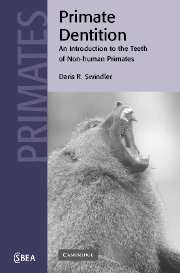6 - Ceboidea
Published online by Cambridge University Press: 05 October 2009
Summary
Family Cebidae
General dental information
Permanent dentition: I2-C1-P3-M3 / I2-C1-P3-M3
Deciduous dentition: di2-dc1-dp3 / di2-dc1-dp3
The above dental formulas are the same for all New World monkeys with the exception of the callitrichines that have only two permanent molars. All New World monkeys have three upper and lower permanent premolars. The dental formulas are not repeated for each of the subfamilies.
Subfamily Callitrichinae
Present distribution and habitat
Members of the Callitrichinae are the smallest of the New World primates and are made up of the marmosets, tamarins, and Goeldi's marmoset (Callimico). The marmosets include two genera, Callithrix and Cebuella, and there are also two genera in the tamarins, Saguinus and Leontopithecus. The callitrichines live in the tropical and montane rain forests of Central and South America. Saguinus is found as far north as Panama but the other genera are limited to South America.
All callitrichines are arboreal, spending the majority of their lives in trees. Their locomotion is squirrel-like, consisting of quick, jerky movements across the substrate, described as scansorial leaping and clinging (Rosenberger, 1992). Because their digits possess claws, except the big toe, they are able to cling to the sides of trees to feed on gums and insects.
Information
- Type
- Chapter
- Information
- Primate DentitionAn Introduction to the Teeth of Non-human Primates, pp. 96 - 122Publisher: Cambridge University PressPrint publication year: 2002
Accessibility standard: Unknown
Why this information is here
This section outlines the accessibility features of this content - including support for screen readers, full keyboard navigation and high-contrast display options. This may not be relevant for you.Accessibility Information
- 1
- Cited by
